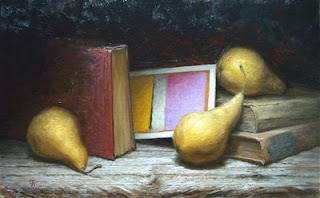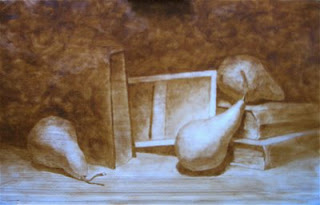http://www.wallacecollection.org/collections/exhibition/77
Although the paintings are closer to the illicit chalk-on-blackboard doodles of a girlfriend-less teenage heavy metal fan being held in after-school detention than to the Titian masterpieces in the adjacent room, Hirst's conversion to painting is enthusiastic and unequivocal. In his own words:
"Conceptual or minimal art seems a bit dead."
Seismic tremors and rumblings indicating that realism could be the "value stock" in an uncertain market have even reached Op-Ed pages of the New York Times, which asks "Has Conceptual Art Jumped the Shark Tank?"
The Gauntlet is Tossed
At Art Basel Miami I debated Hirst's legacy as a conceptual artist with a curator, making the case that his previous work was entertaining gimmickry. By "gimmickry" I mean that the artistic merit of the piece is a function of the production budget, which fuels the marketing buzz in a self-reinforcing loop. I claimed that any clever gent could easily come up with a brilliant concept if given a $20 million budget for its execution (this figure was the cost of Hirst's diamond-encrusted skull).
Swinging for the Fences with $20 Million
My concept is entitled "Canned Almanac 2010." My budget: $20 million. The work will hold a mirror up to the face of the current global economic and cultural order.
A beef cow will be selected from a random midwestern American slaughterhouse. The bovine carcass will be launched into near-earth orbit on a commercial rocket. The capsule will circle the earth three times where it will be visible in the night sky to the world's population. The heat of re-entry cooks the carcass leaving a charred cinder. After dramatically impacting the earth, the cow's remains will be packaged into ordinary unlabeled aluminum soup cans.
I hereby submit the "importance" and "relevance" of this piece:
- The work is historically important, as it sits at the intersection of Pop and Post-Modern conceptual art, seamlessly referencing Damien Hirst's animal carcasses, Warhol's soup cans, Piero Manzoni's cans of feces, and Christo's oil barrels.
- The work is relevant because it informs the current ecological crisis debate by using a staggering quantity of fossil fuels to generate a nutritionally worthless food item that is distributed to an anonymous public via internet marketing channels. In this way it exposes the absurdity of the post-industrial global consumer product system.
- The work deconstructs notions of the value of cultural productions, as it simultaneously rejects and embraces the art market's valuation process by giving away cultural production to random recipients who may be art world outsiders, while at the same time exploiting an insider art transaction and netting out at zero "profit".
- The work explores the relationship between physical mortality and cultural permanence, as the dead cow is resurrected as a permanent art icon which invests the meat with cultural value while maintaining its essential meaninglessness.
- The work redefines the commoditization of art by turning the pop art notion of commodity art on its head. Rather than re-contextualizing a cheap mass-produced product, it creates an undifferentiated and useless end product at a massive expense and then cheapens it by giving it away to anonymous "owners".
- By using an internet lottery to distribute the artworks irrespective of insider status, the work subverts the structure of institutionally sanctioned access channels to cultural information.
- The work subverts the art market's cultural product distribution norms, because the distribution of the artworks are a function of random digital interconnectivity over social networks.
- The work challenges bourgeois notions of provenance and ownership in that the initial owners will be anonymous, and the cans of meat will be indistinguishable from a normal supermarket product.





























